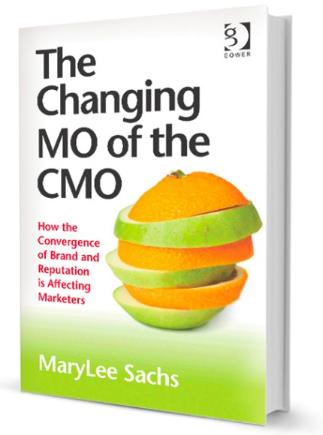The Changing MO of the CMO – How the Convergence of Brand and Reputation is Affecting Marketers Globally - MaryLee Sachs

Welcome MaryLee Sachs, our newest MediaBizBlogger
The principal analyst in marketing leadership at Forrester, Chris Stutzman, spoke at the CMO Club Spring Summit and echoed many findings from the white paper he created for his organization, "CMO Mandate: Adapt Or Perish". According to the research, a staggering 75 percent of marketers plan to re-organize their function by the end of 2011.
It's not surprising given the rate of change and the increasing importance of reputation. According to a 2010-2011 white paper by Prophet entitled "Reputation Winners and Losers", there is a clear relationship between reputation and brand: "Actively managing your reputation will ensure you are not negatively impacting the value of your brand. In addition, it suggests that brand and reputation strategies should be highly linked and should not be kept in separate silos to achieve optimal results for a company overall." So expect some silo-busting as the convergence of brand and reputation disrupts the traditional marketing model as never before, driving a more holistic approach to marketing.
The recent Cannes Lions International Festival of Creativity provided yet another marker to the blurring lines between marketing and communications. Even the Festival organizers changed the name of this year's Festival to "Creativity" from "Advertising" which was its moniker for its first 57 years.
One of the best tweets from the Festival was "Tell me I will forget, show me and I might understand, engage me and I will remember" as reported by M&M Magazine– the telling direction of the new marketing discipline.
The Changing MO of the CMO examines specifically how senior marketers from both B2C and B2B organizations are blending traditional marketing approaches with communications and engagement. The book is based on research and interviews with CMOs from leading organizations and brands with global reach and/or perspective. Here follows a condensed version of Chapter 12 on the global imperative.
B2B organizations are blending traditional marketing approaches with communications and engagement. The book is based on research and interviews with CMOs from leading organizations and brands with global reach and/or perspective. Here follows a condensed version of Chapter 12 on the global imperative.
Chapter 12 – The Global Imperative
Big multi-national brands in developed markets such as North America and Western Europe are increasing their focus and resources outside their home markets where growth potential is greatest versus the saturated and depressed western markets. According to Advertising Age's annual 100 Global Marketers report published in December 2010, the US is home to only five percent of the world's population, however it accounts for 20 percent of the global GDP and 34 percent of the total worldwide advertising, making the US the largest ad market by far. But marketers in the US and other western markets are recognizing the opportunity to reach the remaining 95 percent of consumers in the world, and are shifting spend and resources accordingly. At the same time, brands from developed markets in Asia and Latin America are looking to tap into the lucrative west where consumers are more affluent and always looking for the next new thing despite being showered with choice already.
Regardless of their home base, CMOs will need to market where they see the most opportunity for growth and expansion. And aspects of an organization's social "graph" – how it engages with its audiences or its brand reputation – will continue to transcend borders, making the global CMO role even more complex and challenging.
The results of EffectiveBrands' 2009 Leading Global Brands study, which includes responses from some 21,500 global marketers who work on over 250 brands across all industries, indicated that getting the right balance between local versus global is a top challenge. Nearly 65 percent of respondents confirmed that global brands have become more important over the last five years. But only 15 percent fully agreed that their global brands were effectively leveraging scale. Even fewer marketers believed that their organizations excelled at quickly rolling out successful global brand initiatives.
The fact that the market is globalizing, according to Marc de Swaan Arons and Frank van den Driest in their book The Global Brand CEO, is probably the single biggest challenge for CMOs. Almost all of the things keeping marketers awake at night are connected to the global marketplace and going global. According to de Swaan Arons at a Marketing 50 summit in 2010, marketing used to be like bowling – lining up the pins and driving one big ball down the center of the alley to hit as many pins as possible. Today, global marketing is more like pinball. While one can exert some control on the flaps, there's a lot less control than a traditional marketer is accustomed to. Consumers and other important stakeholders have the control.
Brands also now operate in a fully transparent world where authenticity and relevance reign supreme. Nowhere is this more acute than in the digital and social media space. Despite language differences, the web represents the most global of all channels and as such, should be centrally-led or coordinated, at least from an organizing principle, to ensure consistency in brand image, messaging and reputation. And if organizations haven't figured out their organizing principles yet, it will only get tougher to do so. Tom Friedman once said, "The World is Flat"; Mary Meeker, when she was at Morgan Stanley, said that "It's also increasingly in the palm of your hand." Consumer and other important audiences are finding new ways to do old things faster and better than ever before, and more affordably, thanks to traditional innovators such as Apple, Google and Amazon, as well as new innovators such as Facebook, Skype, Twitter, Hulu and Zynga. Brands simply cannot afford to appear differently and have inconsistent messaging depending on the market.
Newer and more adept competition also presents a marketing leadership and organizational challenge, particularly for larger, more siloed organizations which are often slower to respond, let alone innovate.
One of the most challenging aspects for global marketers is around the role and responsibilities, which seem to vary widely from organization to organization in terms of the functions that report into marketing, the balance between local and regional or global, and the level of connectivity with peers such as the CFO and the CTO.
So what does this all mean for CMOs? There are many key questions around global marketing which seem to be rising to the top of the priority list for many CMOs, and which are outlined in detail in the book as a sort of checklist. Bottom line though, clearly CMOs need a vision for their brands and their businesses, but they also need to orchestrate and coordinate insights and intelligence, ideas and best practice, globally.
MaryLee Sachs was most recently US Chair and Worldwide Director of Consumer Marketing at WPP firm Hill & Knowlton. She launched her new book, The Changing MO of the CMO, How the Convergence of Brand and Reputation is Affecting Marketers, at the Cannes Lions International Festival of Creativity on June 23. The book is available on Amazon and Barnes & Noble.
Read all MaryLee's MediaBizBloggers commentaries at MaryLee Sachs.
Check us out on Facebook at MediaBizBloggers.com
Follow our Twitter updates @MediaBizBlogger
The opinions and points of view expressed in this commentary are exclusively the views of the author and do not necessarily represent the views of MediaBizBloggers.com management or associated bloggers. MediaBizBloggers is an open thought leadership platform and readers may share their comments and opinions in response to all commentaries.


